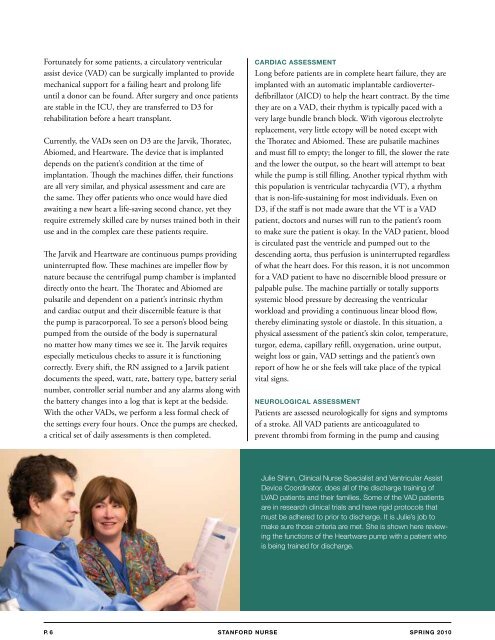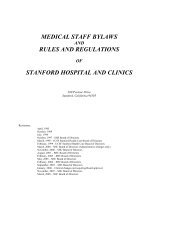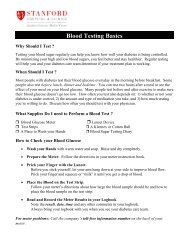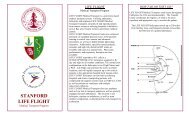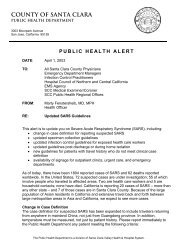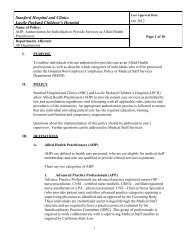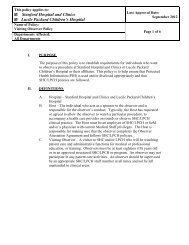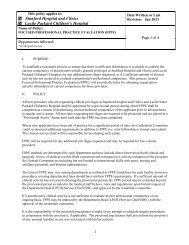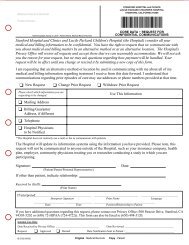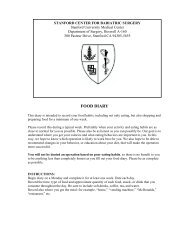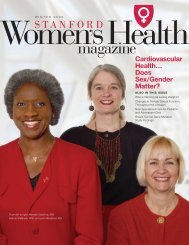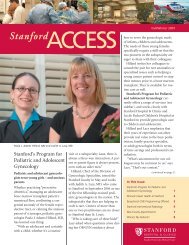SpRiNG 2010 - Stanford Hospital & Clinics
SpRiNG 2010 - Stanford Hospital & Clinics
SpRiNG 2010 - Stanford Hospital & Clinics
You also want an ePaper? Increase the reach of your titles
YUMPU automatically turns print PDFs into web optimized ePapers that Google loves.
Fortunately for some patients, a circulatory ventricular<br />
assist device (VAD) can be surgically implanted to provide<br />
mechanical support for a failing heart and prolong life<br />
until a donor can be found. After surgery and once patients<br />
are stable in the ICU, they are transferred to D3 for<br />
rehabilitation before a heart transplant.<br />
Currently, the VADs seen on D3 are the Jarvik, Thoratec,<br />
Abiomed, and Heartware. The device that is implanted<br />
depends on the patient’s condition at the time of<br />
implantation. Though the machines differ, their functions<br />
are all very similar, and physical assessment and care are<br />
the same. They offer patients who once would have died<br />
awaiting a new heart a life-saving second chance, yet they<br />
require extremely skilled care by nurses trained both in their<br />
use and in the complex care these patients require.<br />
The Jarvik and Heartware are continuous pumps providing<br />
uninterrupted flow. These machines are impeller flow by<br />
nature because the centrifugal pump chamber is implanted<br />
directly onto the heart. The Thoratec and Abiomed are<br />
pulsatile and dependent on a patient’s intrinsic rhythm<br />
and cardiac output and their discernible feature is that<br />
the pump is paracorporeal. To see a person’s blood being<br />
pumped from the outside of the body is supernatural<br />
no matter how many times we see it. The Jarvik requires<br />
especially meticulous checks to assure it is functioning<br />
correctly. Every shift, the RN assigned to a Jarvik patient<br />
documents the speed, watt, rate, battery type, battery serial<br />
number, controller serial number and any alarms along with<br />
the battery changes into a log that is kept at the bedside.<br />
With the other VADs, we perform a less formal check of<br />
the settings every four hours. Once the pumps are checked,<br />
a critical set of daily assessments is then completed.<br />
cARDiAc ASSESSMENT<br />
Long before patients are in complete heart failure, they are<br />
implanted with an automatic implantable cardioverterdefibrillator<br />
(AICD) to help the heart contract. By the time<br />
they are on a VAD, their rhythm is typically paced with a<br />
very large bundle branch block. With vigorous electrolyte<br />
replacement, very little ectopy will be noted except with<br />
the Thoratec and Abiomed. These are pulsatile machines<br />
and must fill to empty; the longer to fill, the slower the rate<br />
and the lower the output, so the heart will attempt to beat<br />
while the pump is still filling. Another typical rhythm with<br />
this population is ventricular tachycardia (VT), a rhythm<br />
that is non-life-sustaining for most individuals. Even on<br />
D3, if the staff is not made aware that the VT is a VAD<br />
patient, doctors and nurses will run to the patient’s room<br />
to make sure the patient is okay. In the VAD patient, blood<br />
is circulated past the ventricle and pumped out to the<br />
descending aorta, thus perfusion is uninterrupted regardless<br />
of what the heart does. For this reason, it is not uncommon<br />
for a VAD patient to have no discernible blood pressure or<br />
palpable pulse. The machine partially or totally supports<br />
systemic blood pressure by decreasing the ventricular<br />
workload and providing a continuous linear blood flow,<br />
thereby eliminating systole or diastole. In this situation, a<br />
physical assessment of the patient’s skin color, temperature,<br />
turgor, edema, capillary refill, oxygenation, urine output,<br />
weight loss or gain, VAD settings and the patient’s own<br />
report of how he or she feels will take place of the typical<br />
vital signs.<br />
NEUROlOGicAl ASSESSMENT<br />
Patients are assessed neurologically for signs and symptoms<br />
of a stroke. All VAD patients are anticoagulated to<br />
prevent thrombi from forming in the pump and causing<br />
Julie shinn, Clinical nurse specialist and Ventricular assist<br />
Device Coordinator, does all of the discharge training of<br />
LVaD patients and their families. some of the VaD patients<br />
are in research clinical trials and have rigid protocols that<br />
must be adhered to prior to discharge. It is Julie’s job to<br />
make sure those criteria are met. she is shown here reviewing<br />
the functions of the Heartware pump with a patient who<br />
is being trained for discharge.<br />
p. 6 STANFORD NURSE<br />
<strong>SpRiNG</strong> <strong>2010</strong>


